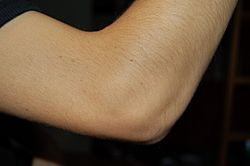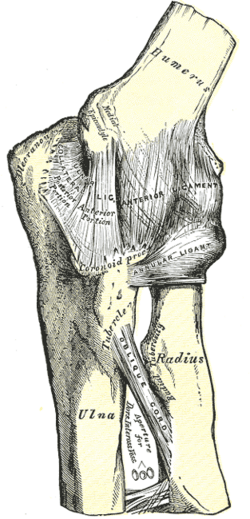Elbow facts for kids
Quick facts for kids Elbow-joint |
|
|---|---|
 |
|
| Elbow | |
 |
|
| Left elbow-joint, showing anterior and ulnar collateral ligaments. | |
| Latin | articulatio cubiti |
| Gray's | subject #84 321 |
| MeSH | Elbow+joint |
Your elbow is a special hinge-joint that connects the bones of your upper and lower arm. It links the humerus bone in your upper arm with the radius and ulna bones in your forearm. You have two elbows, one on each arm!
The elbow allows your lower arm to straighten (extend) or bend (retract). It also helps you turn your arm. This movement is possible thanks to strong tissues called ligaments. These include the anterior, posterior, ulnar collateral, and radial collateral ligaments.
How Your Elbow Works
The main job of your elbow joint is to help you bend and straighten your arm. This lets you reach for and grasp objects. Your elbow can move from being completely straight (0 degrees of elbow extension) to fully bent (about 150 degrees of elbow flexion).
Several muscles help your elbow move:
- Bending muscles: The biceps brachii, brachialis, and brachioradialis muscles help you bend your arm.
- Straightening muscles: The triceps and anconeus muscles help you straighten your arm.
In humans, the elbow's most important role is to place your hand exactly where you need it. It does this by making your arm longer or shorter. There's another small joint nearby called the superior radioulnar joint. While it shares a capsule with the elbow, it doesn't help the elbow move.
When your elbow is straight, the bones of your upper arm and forearm line up. This special setup allows your arm to bend almost completely. The muscles that move your forearm are grouped on the sides of the joint. This keeps them from getting in the way of your elbow's movement.
The Carrying Angle
When you straighten your arm with your palm facing forward or up, your upper arm bone (humerus) and forearm bones (radius and ulna) don't form a perfectly straight line. Instead, your forearm angles slightly outward, away from your body. This slight bend is called the "carrying angle." You can see it in the right part of the picture.
The carrying angle is helpful because it lets you swing your arm without hitting your hips. On average, women tend to have a slightly larger carrying angle than men. However, there's a lot of overlap between individuals. Recent studies with many participants suggest that the carrying angle can be a unique feature between sexes.
Interestingly, the carrying angle is often a bit larger in your dominant arm (the one you use most) compared to your non-dominant arm. This suggests that the way you use your arm can change this angle over time. Your age, development, and even your background can also affect your carrying angle.
See also
 In Spanish: Articulación del codo para niños
In Spanish: Articulación del codo para niños


